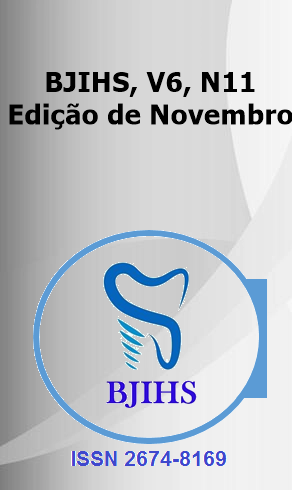Abstract
Pulmonary embolism occurs when an embolus blocks the pulmonary arteries, often as a result of deep vein thrombosis. The condition is severe, with high morbidity and mortality and nonspecific clinical signs, which makes diagnosis difficult. Risk factors include previous deep vein thrombosis, prolonged immobilization, and obesity, highlighting the need for early diagnosis to reduce complications. This article aims to analyze the epidemiological profile of pulmonary embolism in Brazil from 2013 to 2023, using data from the SUS Hospital Information System. The observational, retrospective, and descriptive study showed a reduction in the pulmonary embolism mortality rate, but a significant increase in hospitalizations. A total of 100,881 hospitalizations were recorded, predominantly in the Southeast Region, but with a progressive increase in the Northeast. Most hospitalizations occurred in the elderly (51%), with a higher incidence in women (61.1%) and whites (57.8%). 18,658 deaths were recorded, with an increase of 46% between 2013 and 2023, most of them occurred in individuals over 60 years of age (69.4%), women (59%), whites (43.7%) and browns (29%). There were more deaths in the Southeast (54.8%), while the Northeast had the highest mortality rate (24.02). Comorbidities, such as cardiovascular diseases, aggravate the clinical condition and increase the chances of hospitalization. There are regional disparities in Brazil, with higher mortality rates in regions with poor sanitary infrastructure. Aging increases the risk of pulmonary embolism, increasing hospitalization among the elderly. Women are more susceptible to thromboembolic diseases, but men have higher mortality. Racial differences in pulmonary embolism incidence and mortality show greater lethality among blacks. We conclude that more research is needed to understand the pulmonary embolism scenario in Brazil, as well as the need for public policies that consider regional disparities, aging and gender and race differences.
References
ALBRICKER, A. C. L. et al. Diretriz Conjunta sobre Tromboembolismo Venoso – 2022. Arquivos Brasileiros de Cardiologia, v. 118, n. 4, p. 797-857, 2022.
BAPTISTA, E. et al. The relation between cardiovascular mortality and development: study for small areas in Brazil, 2001-2015. Demographic Research, v. 41, n. 51, p. 1437-1452, 2019.
BARCO, S. et al. Global reporting of pulmonary embolism–related deaths in the World Health Organization mortality database: vital registration data from 123 countries. Research And Practice In Thrombosis And Haemostasis, v. 5, n. 5, p. e12520, 2021.
BRASIL. Ministério da Saúde. Política Nacional de Saúde Integral da População Negra: uma política para o SUS. Brasília, DF: Ministério da Saúde, 2017.
CHAIMOWICZ, F., CHAIMOWICZ, B. F. Por quais razões adoecem e morrem os idosos no Brasil? Pist Periódico Interdiscip, v. 4, n. 2, p. 27–57, 2022.
CLARK, A. C. et al. Pulmonary Embolism: epidemiology, patient presentation, diagnosis, and treatment. Journal Of Radiology Nursing, v. 38, n. 2, p. 112-118, 2019.
DARZE, E. S. et al. Pulmonary embolism mortality in Brazil from 1989 to 2010: gender and regional disparities. Arquivos Brasileiros de Cardiologia, v. 106, n. 1, p. 4-12, 2016.
DOHERTY, S. Pulmonary embolism: an update. Aust Fam Physician, v. 46, n. 11, p. 816-820, 2017.
GOMES, J. A. et al. Hospitalizations for pulmonary embolism in Brazil (2008-2019): an ecological and time series study. Jornal Brasileiro de Pneumologia, v. 48, n. 3, p. e20210434, 2022.
HONG, J. et al. Incidence of venous thromboembolism in Korea from 2009 to 2013. Plos One, v. 13, n. 1, p. e0191897, 2018.
HOSKIN, S. et al. Trends in acute pulmonary embolism admission rates and mortality outcomes in Australia, 2002–2003 to 2017–2018: a retrospective cohort study. Thrombosis And Haemostasis, v. 121, n. 09, p. 1237-1245, 2021.
IBGE. Instituto Brasileiro de Geografia e Estatística. Censo Brasileiro de 2022. Rio de Janeiro: IBGE, 2022. Disponível em: https://censo2022.ibge.gov.br/sobre/conhecendo-o-brasil.html. Acesso em: 31 jul 2024.
MIGUEL-DÍEZ, J. et al. Trends in hospital admissions for pulmonary embolism in Spain from 2002 to 2011. European Respiratory Journal, v. 44, n. 4, p. 942-950, 2014.
MIRANDA, C. H. et al. Pulmonary embolism: an underdiagnosed and underreported entity in Brazil. Jornal Brasileiro de Pneumologia, v. 48, n. 4, p. e20220207, 2022.
NORMANDO, P. G. et al. Redução de hospitalizações e aumento da mortalidade por doenças cardiovasculares durante a pandemia de COVID-19 no Brasil. Arquivos Brasileiros de Cardiologia, v. 116, n. 3, p. 371-380, 2021.
PRATES, A. L. M. et al. Internações por embolia pulmonar no Brasil (2019-2023): epidemiologia e despesas públicas. Research, Society And Development, v. 13, n. 3, p. e10913345311, 2024.
SANTOS, P. R. S. et al. Análise do perfil epidemiológico de óbitos por embolia pulmonar no Brasil de 2018 a 2023. Brazilian Journal Of Implantology And Health Sciences, v. 5, n. 5, p. 253-261, 2023.
SATHIANATHAN, S. et al. Racial and gender disparities in the management of acute pulmonary embolism. Journal Of Vascular Surgery, v. 12, n. 3, p. 101817, 2024.
SILVA, L. O. et al. Artificial intelligence-based pulmonary embolism classification: development and validation using real-world data. Plos One, v. 19, n. 8, p. e0305839, 2024.
SMITH, S. B. et al. Analysis of national trends in admissions for pulmonary embolism. Chest, v. 150, n. 1, p. 35-45, 2016.
THACHIL, R. et al. Pulmonary embolism in women: a systematic review of the current literature. Journal Of Cardiovascular Development And Disease, v. 9, n. 8, p. 234, 2022.
YAVUZ, A. et al. Surgical embolectomy for acute massive pulmonary embolism. Int J Clin Exp Med, v. 7, n. 12, p. 5362-5375, 2014.

This work is licensed under a Creative Commons Attribution 4.0 International License.
Copyright (c) 2024 Ráysson Ribeiro da Costa, Esthela Ferreira Araujo Vieira, Rafaela Rayane Aguiar, Michely Laiany Vieira Moura
